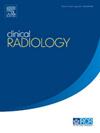基于mri放射组学模型的儿童静脉畸形术前分类预测
IF 2.1
3区 医学
Q2 RADIOLOGY, NUCLEAR MEDICINE & MEDICAL IMAGING
引用次数: 0
摘要
目的本研究旨在探讨基于mri的放射组学模型,采用各种机器学习技术,在术前预测静脉畸形(vm)的数字减影血管造影(DSA)分类中的效果。材料和方法本回顾性研究将153名儿童的160个VM病变分为训练集(n=128)和测试集(n=32)。从术前MRI扫描中提取放射学特征。使用类内相关系数检验、z分数、K-best方法和最小绝对收缩和选择算子执行特征选择。不同的MRI序列和机器学习方法为放射组学模型的发展奠定了基础。采用受试者工作特征曲线和曲线下面积(AUC)评价模型的疗效。结果在CET1和T2影像的4528个放射学特征中,有9个特征与DSA分类分化有显著相关性。预测虚拟机DSA分类最有效的模型结合了这9个特征,并采用了随机森林分类器。该模型在训练集中的识别AUC为0.917,在测试集中的识别AUC为0.891。结论利用CET1和T2序列的随机森林模型对vm的DSA分类有较好的预测效果。本文章由计算机程序翻译,如有差异,请以英文原文为准。
MRI-based radiomics model for the preoperative prediction of classification in children with venous malformations
Aim
This study aimed to explore the efficacy of MRI-based radiomics models, employing various machine learning techniques, in the preoperative prediction of the digital subtraction angiography (DSA) classification of venous malformations (VMs).
Materials and methods
In this retrospective study, 160 VM lesions from 153 children were categorized into a training set (n=128) and a testing set (n=32). Radiomic features were extracted from preoperative MRI scans. Feature selection was executed using the intraclass correlation coefficient test, z-scores, the K-best method, and the least absolute shrinkage and selection operator. Diverse MRI sequences and machine learning methods underpinned the development of the radiomics models. The models' efficacy was evaluated using receiver operating characteristic curves and the area under the curve (AUC).
Results
Out of 4528 radiomic features derived from CET1 and T2 images, 9 features were significantly associated with DSA classification differentiation. The most effective model for predicting VMs' DSA classification incorporated these 9 features and employed a random forest classifier. This model achieved an AUC of 0.917 in the training set and an excellent discrimination AUC of 0.891 in the testing set.
Conclusion
The random forest model, utilizing CET1 and T2 sequences, exhibited outstanding predictive performance in the preoperative distinction of VMs' DSA classification.
求助全文
通过发布文献求助,成功后即可免费获取论文全文。
去求助
来源期刊

Clinical radiology
医学-核医学
CiteScore
4.70
自引率
3.80%
发文量
528
审稿时长
76 days
期刊介绍:
Clinical Radiology is published by Elsevier on behalf of The Royal College of Radiologists. Clinical Radiology is an International Journal bringing you original research, editorials and review articles on all aspects of diagnostic imaging, including:
• Computed tomography
• Magnetic resonance imaging
• Ultrasonography
• Digital radiology
• Interventional radiology
• Radiography
• Nuclear medicine
Papers on radiological protection, quality assurance, audit in radiology and matters relating to radiological training and education are also included. In addition, each issue contains correspondence, book reviews and notices of forthcoming events.
 求助内容:
求助内容: 应助结果提醒方式:
应助结果提醒方式:


